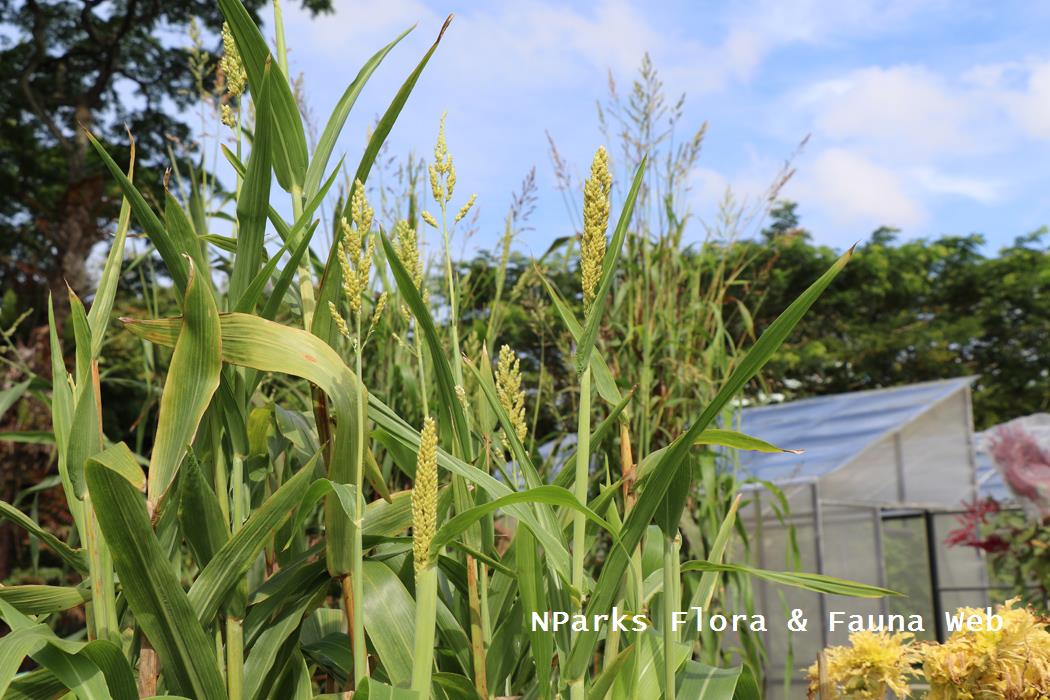
Name
Classifications and Characteristics
| Plant Division | Angiosperms (Flowering Seed Plants) |
|---|---|
| Plant Growth Form | Grass or Grass-like Plant |
| Mode of Nutrition | Autotrophic |
Description and Ethnobotany
| Growth Form | Annual erect herb up to 2.4 m tall. |
|---|---|
| Foliage | The green, strap-shaped leaves are hairless and resemble those of corn (40-70 cm long, 3-8 cm wide). The leaf base is a leaf sheath which clasps the stem. The ligule (a flap of tissue at the leaf base) is approximately round and lined with short hairs. |
| Stems | The round stem is solid and waxy (2-5 cm wide). |
| Flowers | The loose, branched inflorescence is known as a panicle. It is composed of stalkless spikelets. |
| Fruit | The dry indehiscent fruit is known as a caryopsis and resembles a shiny, black seed. |
| Similar | Sorghum is sometimes confused with corn, because they have similar form and leaf shape. |
| Cultivation | Plants are ready to harvest at about 90-110 days. Space plants about 2.5-5 cm apart; the tight spacing provides structural support for the tall stems. It needs regular watering before establishment, but little watering afterwards. Once the seedheads form, no more watering is required. For seed harvesting, wait until the seed-like fruits are completely dry before collecting the seed. If you press the fruit and milky sap spills out, the seed is still immature, but the stalk may be ready for pressing. |
| Etymology | The cultivar is called Black Amber, because it produces black, shiny seed-like fruits. |
| Ethnobotanical Uses | Edible Plant Parts : Edible Stems, Edible Seeds Food (Fruit or Vegetable): The seeds can be cooked like rice. It contains as much protein as wheat, both having more protein than corn. In Haiti, the seeds are used to make porridge which is eaten with green peas. Agriculture - Forestry: The grain is fed to livestock as fodder. Others: The stems can be pressed to produce a sweet, brown syrup which is called molasses or sorghum syrup. |
Landscaping Features
| Landscape Uses | Parks & Gardens |
|---|---|
| Thematic Landscaping | Economic Garden |
Plant Care and Propagation
| Light Preference | Full Sun |
|---|---|
| Water Preference | Moderate Water |
| Rootzone Tolerance | Drought Tolerant, Well-Drained Soils, Easy to Grow |
| Maintenance Requirements | Moderate |
| Propagation Method | Seed |
Foliar
| Foliage Retention | Evergreen |
|---|---|
| Mature Foliage Colour(s) | Green |
| Mature Foliage Texture(s) | Smooth |
| Prominent Young Flush Colour(s) | Green |
| Young Flush Texture(s) | Smooth |
| Foliar Type | Simple / Unifoliate |
| Foliar Arrangement Along Stem | Alternate |
| Foliar Attachment to Stem | Sessile |
| Foliar Shape(s) | Non-Palm Foliage (Linear) |
| Foliar Venation | Parallel |
| Foliar Margin | Entire |
| Foliar Apex - Tip | Acuminate |
| Foliar Base | Clasping |
| Typical Foliar Area | Macrophyll ( 182.25cm2 - 1640.25 cm2 ) |
Floral (Angiosperm)
| Flower Colour(s) | Cream / Off-White |
|---|---|
| Flower Grouping | Cluster / Inflorescence |
| Flower Location | Terminal |
| Flower Symmetry | Asymmetrical |
| Inflorescence Type | Panicle |
| Flowering Opening Time | Daytime |
| Flower Lifespan on Plant | Several Days |
| Flowering Habit | Polycarpic |
Image Repository
Others
| Master ID | 32976 |
|---|---|
| Species ID | 7390 |
| Flora Disclaimer | The information in this website has been compiled from reliable sources, such as reference works on medicinal plants. It is not a substitute for medical advice or treatment and NParks does not purport to provide any medical advice. Readers should always consult his/her physician before using or consuming a plant for medicinal purposes. |





